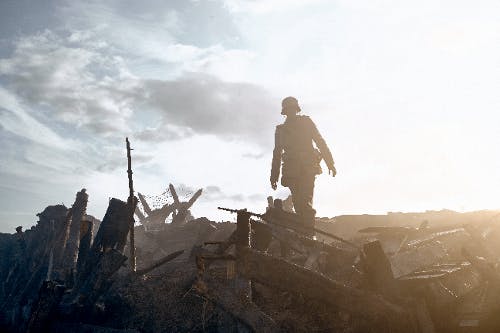All the Gore and More of ‘All Quiet on the Western Front’
Based on the renowned novel many of us read in high school or college, the new movie retains some of the book’s characters and key events, though it modifies them to create a heightened narrative endpoint.

The phrase “shell shock” was first used in an official document in 1915 by an English medical officer, though the coinage of the term is often ascribed to World War I soldiers. Plainly, it defined how the “shelling” “shocked” the nerves of affected troopers. Today, we use the term “post-traumatic stress disorder” to describe what happens to someone who has experienced a jolting, terrible experience, but shell shock remains the more direct expression.
The new movie “All Quiet on the Western Front” (available on Netflix and in select theaters) definitely delivers shocks and graphic deaths in its portrayal of the horrors of World War I — as it should be. Based on the renowned novel many of us read in high school or college, the movie retains some of the book’s characters and key events, though it modifies them to create a heightened narrative endpoint.
It departs most from Erich Maria Remarque’s classic when it addresses the political machinations of the peace negotiations near the end of the war. This new version is also different in many ways from the 1930 film that won an Academy Award for Outstanding Production, the Best Picture designation of its day.
Directed by German Edward Berger, the new adaptation makes use of color, sound, and digital technology to immediately immerse the viewer in battle. In the first of many combat scenes, the very air and dirt around the trenches seems soaked in blood, and when the setting moves to a nearby town the art direction mirrors this scarlet atmosphere by highlighting red buildings and cars. The sound design confronts us with mortar crashes and rapid gunfire, and a little later the soundtrack complements this chaos with blasts of blaring synthesizer sounds and drumming.
This opening battle and its aftermath, which follows how the uniforms of dead soldiers were recycled and restored in order to be used by new recruits, is one of many bravura sequences found in the film. Another occurs about an hour in and while it’s another battlefield encounter, this sequence is one of the longest and most brutal war scenes this viewer has ever seen, reminding me of the devastating Normandy landing set piece in Spielberg’s “Saving Private Ryan.” Compared with recent WWI movies, this series of scenes alone puts to shame the one-shot gimmickry of “1917” and the niceties of “Joyeux Noël,” despite great moments in both movies.
While tank warfare is introduced and flame throwers set ablaze everything within range during this sequence, the film crosscuts to German politicians and military men meeting with French officials to hash out an armistice. The great German actor Daniel Brühl, who also starred in “Joyeux Noël,” heads the German contingent but there is really nothing to negotiate; the French, with an acknowledged assist from the Americans, have depleted the German forces and unconditional surrender is the only option.
Another element not in the novel is a German general who abhors the terms of the peace agreement and, just before the war is to be declared officially over, orders his troops to re-take an area called “Latierre” from the French. Fighting did continue in this manner, yet some viewers may balk at this deviation from the source material. It seems that in trying to maintain some sort of three-act structure and drive the pace of the movie as it nears its finish, Mr. Berger comes perilously close to glorifying violence by employing yet another epic battle sequence.
While the director’s efforts to show us the larger geo-political picture are commendable, it takes us away from his central characters, four friends we meet at the start of the movie and two other soldiers who join the group. Still, all the actors are fantastic, with Felix Kammerer especially heartbreaking as lead character Paul since we see him evolve from naïve and enthusiastic to disillusioned but still hopeful, and finally to wretched and shattered.
In one particularly unforgettable scene, Paul cannot escape his part in the overall atrocity and attempts to help a French soldier he has just stabbed. We witness him have a mental breakdown and then come to what could be called a moral epiphany: He cannot let this man die this way. The moment is excruciating, and it might have made for a great, though admittedly highly unconventional, closer — to end not with a bang but a whimper.

